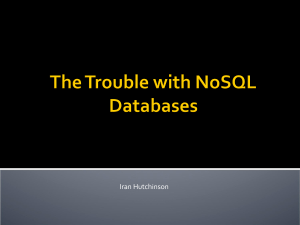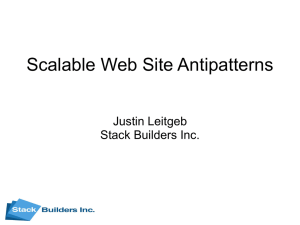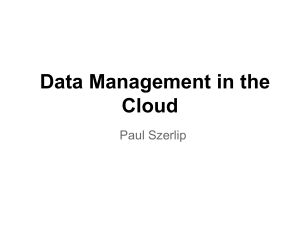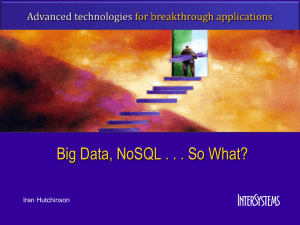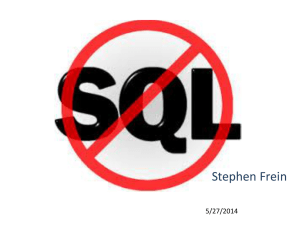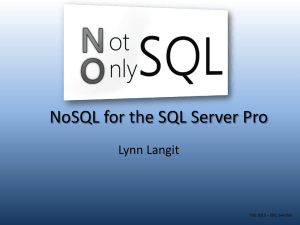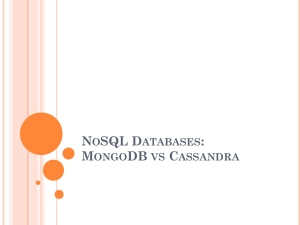08 : NoSQL I
advertisement
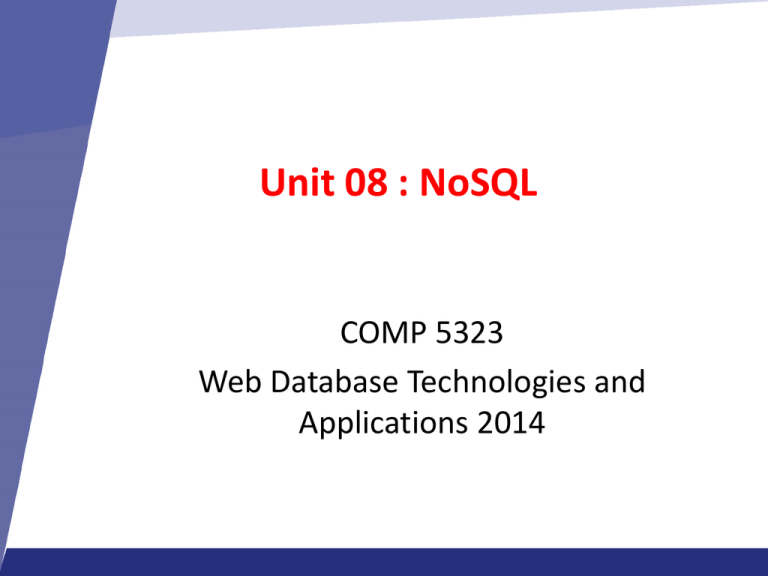
Unit 08 : NoSQL
COMP 5323
Web Database Technologies and
Applications 2014
Doctrine of Fair Use
• This PowerPoint is prepared for educational purpose
and is strictly used in the classroom lecturing.
• We have adopted the "Fair Use" doctrine in this
PowerPoint which allows limited copying of
copyrighted works for educational and research
purposes.
Learning Objectives
• Understand the basic of NoSQL
• Four major types of NoSQL Database
Outline
1. Motivation
2.CAP Theorem
3. Category
4. Typical NoSQL API
1 Motivation
Data Management
• Database Management System (DBMS)
provides our application:
efficient, reliable, convenient, and safe
multi-user storage of and access to
massive
amounts of persistent data.
• Not every data management/analysis
problem is best solved using a
traditional DBMS
Why NoSQL
•
•
•
•
Big data
Scalability
Data format
Manageability
Big Data
•
•
•
•
•
Collect
Store
Organize
Analyze
Share
Data growth outruns the ability to manage it so
we need scalable solutions.
Scalability
• Scale up, Vertical scalability.
– Increasing server capacity.
– Adding more CPU, RAM.
– Managing is hard.
– Possible down times
Scalability
• Scale out, Horizontal scalability.
– Adding servers to existing system with little effort,
aka Elastically scalable
• Bugs, hardware errors, things fail all the time.
• It should become cheaper. Cost efficiency.
– Shared nothing
– Use of commodity/cheap hardware
– Heterogeneous systems
– Controlled Concurrency (avoid locks)
– Symmetry, you don’t have to know what is
happening. All nodes should be symmetric.
NoSQL: The Name
“SQL” = Traditional relational DBMS
Recognition over past decade or so:
Not every data management/analysis
problem is best solved using a traditional
relational DBMS
“NoSQL” = “No SQL” =
Not using traditional relational DBMS
“No SQL” Don’t use SQL language
“NoSQL” =? “Not Only SQL” => NOSQL
NoSQL databases
• The name stands for Not Only SQL
• Common features:
– non-relational
– usually do not require a fixed table schema
– horizontal scalable
– mostly open source
• More characteristics
– relax one or more of the ACID properties (see CAP
theorem)
– replication support
– easy API (if SQL, then only its very restricted variant)
• Do not fully support relational features
– no join operations (except within partitions),
– no referential integrity constraints across partitions.
Anecdote
• Johan Oskarsson wanted to organize an event to
discuss open-source distributed databases in 2009
• Johan wanted a name for the meeting – something
that would make a good Twitter hashtag: short,
memorable, and without too many Google hits so
that a search on the name would quickly find the
meetup.
• He asked for suggestions on the #cassandra IRC
channel and got a few, selecting the suggestion of
“NoSQL” from Eric Evans, a developer at Rackspace.
Example #1: Web log analysis
Each record: UserID, URL, timestamp,
additional-info
Task: Load into database system
Example #1: Web log analysis
Each record: UserID, URL, timestamp,
additional-info
Task: Find all records for…
Given UserID
Given URL
Given timestamp
Certain construct appearing in
additional-info
Example #1: Web log analysis
Each record: UserID, URL, timestamp,
additional-info
Separate records: UserID, name, age, gender,
…
Task: Find average age of user accessing given
URL
Example #2: Social-network graph
Each record: UserID1, UserID2
Separate records: UserID, name, age,
gender etc
Task: Find all friends of friends of friends
of … friends of given user
Example #3: Blog Pages
Large collection of documents
Combination of structured and
unstructured data
Task: Retrieve texts and images
More Programming and Less Database
Design
Alternative to traditional relational DBMS
+ Flexible schema
+ Quicker/cheaper to set up
+ Massive scalability
+ Relaxed consistency higher performance &
availability
– No declarative query language more
programming
– Relaxed consistency fewer guarantees
Challenge: Coordination
• The solution to availability and scalability is to
decentralize and replicate functions and data…but how do
we coordinate the nodes?
– data consistency
– update propagation
– mutual exclusion
– consistent global states
– group membership
– group communication
– event ordering
– distributed consensus
– quorum consensus
2 CAP Theorem
A network partition
consistency
C
Fox&Brewer “CAP Theorem”:
C-A-P: choose two.
CA: available, and consistent,
unless there is a partition.
A
Availability
23
Claim: every distributed
system is on one side of the
triangle.
CP: always consistent, even in a partition,
but a reachable replica may deny service
without agreement of the others (e.g.,
quorum).
AP: a reachable replica provides
service even in a partition, but may be
inconsistent if there is a failure.
P
Partition-resilience
Two Generals in practice
Deduct
$300
Issue
$300
How do banks solve this problem?
Keith Marzullo
Careful ordering is limited
• Transfer $100 from Melissa’s account to mine
1. Deduct $100 from Melissa’s account
2. Add $100 to my account
• Crash between 1 and 2, we lose $100
• Could reverse the ordering
1. Add $100 to my account
2. Deduct $100 from Melissa’s account
• Crash between 1 and 2, we gain $100
• What does this remind you of?
Transactions
• Fundamental to databases
– (except MySQL, until recently)
• Several important properties
– “ACID” (atomicity, consistent, isolated, durable)
– We only care about atomicity (all or nothing)
Called “committing”
the transaction
BEGIN
disk write 1
…
disk write n
END
Transactions: logging
Commit
WriteN
Write1
Begin transaction
Append info about modifications to a log
Append “commit” to log to end x-action
Write new data to normal database
Single-sector write commits x-action (3)
Begin
1.
2.
3.
4.
•
…
Transaction Complete
Invariant: append new data to log before applying to DB
Called “write-ahead logging”
Transactions: logging
Commit
WriteN
…
Write1
Begin transaction
Append info about modifications to a log
Append “commit” to log to end x-action
Write new data to normal database
Single-sector write commits x-action (3)
Begin
1.
2.
3.
4.
•
What if we crash here (between 3,4)?
On reboot, reapply committed updates in log order.
Transactions: logging
WriteN
…
Write1
Begin transaction
Append info about modifications to a log
Append “commit” to log to end x-action
Write new data to normal database
Single-sector write commits x-action (3)
Begin
1.
2.
3.
4.
•
What if we crash here?
On reboot, discard uncommitted updates.
Committing Distributed Transactions
• Transactions may touch data at more than one site.
• Problem: any site may fail or disconnect while a commit for
transaction T is in progress.
– Atomicity says that T does not “partly commit”, i.e.,
commit at some site and abort at another.
– Individual sites cannot unilaterally choose to abort T
without the agreement of the other sites.
– If T holds locks at a site S, then S cannot release them until
it knows if T committed or aborted.
– If T has pending updates to data at a site S, then S cannot
expose the data until T commits/aborts.
Commit is a Consensus Problem
• If there is more than one site, then the sites must
agree to commit or abort.
• Sites (Resource Managers or RMs) manage their own
data, but coordinate commit/abort with other sites.
– “Log locally, commit globally.”
• We need a protocol for distributed commit.
– It must be safe, even if FLP tells us it might not
terminate.
• Each transaction commit is led by a coordinator
(Transaction Manager or TM).
Two-Phase Commit (2PC)
If unanimous to commit
decide to commit
else decide to abort
“commit or abort?” “here’s my vote” “commit/abort!”
TM/C
RM/P
precommit
or prepare
vote
RMs validate Tx and
prepare by logging their
local updates and
decisions
decide
notify
TM logs commit/abort
(commit point)
2PC: Phase 1
✓ 1. Tx requests commit, by notifying coordinator (C)
• C must know the list of participating sites/RMs.
✓ 2. Coordinator C requests each participant (P) to prepare.
✓ 3. Participants (RMs) validate, prepare, and vote.
• Each P validates the request, logs validates updates
locally, and responds to C with its vote to commit or
abort.
• If P votes to commit, Tx is said to be “prepared” at P.
2PC: Phase 2
✓ 4. Coordinator (TM) commits.
• Iff all P votes are unanimous to commit
– C writes a commit record to its log
– Tx is committed.
• Else abort.
✓ 5. Coordinator notifies participants.
• C asynchronously notifies each P of the outcome for Tx.
• Each P logs the outcome locally
• Each P releases any resources held for Tx.
34
34
Handling Failures in 2PC
How to ensure consensus if a site fails during the 2PC
protocol?
1. A participant P fails before preparing.
Either P recovers and votes to abort, or C times
out and aborts.
2. Each P votes to commit, but C fails before committing.
• Participants wait until C recovers and notifies
them of the decision to abort. The outcome is
uncertain until C recovers.
Handling Failures in 2PC
3. P or C fails during phase 2, after the outcome is
determined.
• Carry out the decision by reinitiating the protocol
on recovery.
• Again, if C fails, the outcome is uncertain until C
recovers.
consistency
C
Fox&Brewer “CAP Theorem”:
C-A-P: choose two.
CA: available, and consistent,
unless there is a partition.
A
Availability
Claim: every distributed
system is on one side of the
triangle.
CP: always consistent, even in a partition,
but a reachable replica may deny service
without agreement of the others (e.g.,
quorum).
AP: a reachable replica provides
service even in a partition, but may be
inconsistent.
P
Partition-resilience
Google GFS: Assumptions
• Design a Google FS for Google’s distinct needs
• High component failure rates
– Inexpensive commodity components fail often
• “Modest” number of HUGE files
– Just a few million
– Each is 100MB or larger; multi-GB files typical
• Files are write-once, mostly appended to
– Perhaps concurrently
• Large streaming reads
• High sustained throughput favored over low latency
[Alex Moschuk]
GFS Design Decisions
• Files stored as chunks
– Fixed size (64MB)
• Reliability through replication
– Each chunk replicated across 3+ chunkservers
• Single master to coordinate access, keep metadata
– Simple centralized management
• No data caching
– Little benefit due to large data sets, streaming reads
• Familiar interface, but customize the API
– Simplify the problem; focus on Google apps
– Add snapshot and record append operations
[Alex Moschuk]
GFS Architecture
• Single master
• Mutiple chunkservers
…Can anyone see a potential weakness in this design?
[Alex Moschuk]
Single master
• From distributed systems we know this is a:
– Single point of failure
– Scalability bottleneck
• GFS solutions:
– Shadow masters
– Minimize master involvement
• never move data through it, use only for metadata
– and cache metadata at clients
• large chunk size
• master delegates authority to primary replicas in data mutations
(chunk leases)
• Simple, and good enough!
Fault Tolerance
• High availability
– fast recovery
• master and chunkservers restartable in a few seconds
– chunk replication
• default: 3 replicas.
– shadow masters
• Data integrity
– checksum every 64KB block in each chunk
What is the consensus problem here?
Google Ecosystem
• Google builds and runs services at massive scale.
– More than half a million servers
• Services at massive scale must be robust and adaptive.
– To complement a robust, adaptive infrastructure
• Writing robust, adaptive distributed services is hard.
• Google Labs works on tools, methodologies, and
infrastructures to make it easier.
– Conceive, design, build
– Promote and transition to practice
– Evaluate under real use
Google Systems
•
•
•
•
•
Google File System (GFS) [SOSP 2003]
– Common foundational storage layer
MapReduce for data-intensive cluster computing [OSDI 2004]
– Used for hundreds of google apps
– Open-source: Hadoop (Yahoo)
BigTable [OSDI 2006]
– a spreadsheet-like data/index model layered on GFS
Sawzall
– Execute filter and aggregation scripts on BigTable servers
Chubby [OSDI 2006]
– Foundational lock/consensus/name service for all of the above
– Distributed locks
– The “root” of distributed coordination in Google tool set
What Good is “Chubby”?
• Claim: with a good lock service, lots of distributed
system problems become “easy”.
– Where have we seen this before?
• Chubby encapsulates the algorithms for consensus.
– Where does consensus appear in Chubby?
• Consensus in the real world is imperfect and messy.
– How much of the mess can Chubby hide?
– How is “the rest of the mess” exposed?
• What new problems does such a service create?
Chubby Structure
• Cell with multiple participants (replicas and master)
– replicated membership list
– common DNS name (e.g., DNS-RR)
• Replicas elect one participant to serve as Master
– master renews its Master Lease periodically
– elect a new master if the master fails
– all writes propagate to secondary replicas
• Clients send “master location requests” to any replica
– returns identity of master
• Replace replica after long-term failure (hours)
Master Election/Fail-over
consistency
C
Fox&Brewer “CAP Theorem”:
C-A-P: choose two.
CA: available, and consistent,
unless there is a partition.
A
Availability
Claim: every distributed
system is on one side of the
triangle.
CP: always consistent, even in a partition,
but a reachable replica may deny service
without agreement of the others (e.g.,
quorum).
AP: a reachable replica provides
service even in a partition, but may be
inconsistent.
P
Partition-resilience
Relaxing ACID properties
• ACID is hard to achieve, moreover, it is not always required,
e.g. for blogs, status updates, product listings, etc.
• Availability
– Traditionally, thought of as the server/process available 99.999
% of time
– For a large-scale node system, there is a high probability that a
node is either down or that there is a network partitioning
• Partition tolerance
– ensures that write and read operations are redirected to
available replicas when segments of the network become
disconnected
49
Eventual Consistency
• Eventual Consistency
– When no updates occur for a long period of time, eventually all
updates will propagate through the system and all the nodes
will be consistent
– For a given accepted update and a given node, eventually
either the update reaches the node or the node is removed
from service
• BASE (Basically Available, Soft state, Eventual
consistency) properties, as opposed to ACID
• Soft state: copies of a data item may be inconsistent
• Eventually Consistent – copies becomes consistent at some
later time if there are no more updates to that data item
• Basically Available – possibilities of faults but not a fault of the
whole system
50
CAP Theorem
• Suppose three properties of a system
– Consistency (all copies have same value)
– Availability (system can run even if parts have failed)
– Partitions (network can break into two or more parts, each with active
systems that can not influence other parts)
• Brewer’s CAP “Theorem”: for any system sharing data it is
impossible to guarantee simultaneously all of these three
properties
• Very large systems will partition at some point
– it is necessary to decide between C and A
– traditional DBMS prefer C over A and P
– most Web applications choose A (except in specific applications such
as order processing)
An Elaboration
Consistent and available
No partition.
App
Data
A
Data
B
An Elaboration
Available and partitioned
Not consistent, we get back old data.
App
Data
A
Old Data
B
An Elaboration
Consistent and partitioned
Not available, waiting…
App
New Data
Wait for new data
A
B
CAP Theorem
• Drop A or C of ACID
– relaxing C makes replication easy,
facilitates fault tolerance,
– relaxing A reduces (or eliminates) need
for distributed concurrency control.
4 Category
Quote
Categories of NoSQL databases
•
•
•
•
•
Key-value stores
Column NoSQL databases
Document-based
Graph database (neo4j, InfoGrid)
XML databases (myXMLDB, Tamino, Sedna)
Key-Value Stores
Extremely simple interface
Data model: (key, value) pairs
Operations: Insert(key,value), Fetch(key),
Update(key), Delete(key)
Implementation: efficiency, scalability, faulttolerance
Records distributed to nodes based on key
Replication
Single-record transactions, “eventual consistency
Key-Value Data Stores
• Example: SimpleDB
– Based on Amazon’s Single Storage Service
(S3)
– items (represent objects) having one or more
pairs (name, value), where name denotes an
attribute.
– An attribute can have multiple values.
– items are combined into domains.
Riak
Example
Key-Value Stores
Extremely simple interface
Data model: (key, value) pairs
Operations: Insert(key,value), Fetch(key),
Update(key), Delete(key)
Implementation: efficiency, scalability, faulttolerance
Records distributed to nodes based on key
Replication
Single-record transactions, “eventual consistency”
Suitable Use Cases
• Storing Session Information
• User Profiles, Preferences: Almost every
user has a unique userID as well as
preferences such as language, color,
timezone, which products the user has
access to , and so on.
Shopping Cart Data
• As we want the shopping carts to be available
all the time, across browsers, machines, and
sessions, all the shopping information can be
put into value where the key is the userID
Not to Use
•
•
•
•
Relationships among data
Multi-operation Transactions
Query by Data
Operations by Sets: since operations are
limited to one key at a time, there is no
way to operate upon multiple keys at the
same time. If you need to operate upon
multiple keys, you have to handle this
from the client side
Document Stores
Like Key-Value Stores except value is document
Data model: (key, document) pairs
Document: JSON, XML, other semistructured
formats
Basic operations: Insert(key,document), Fetch(key),
Update(key), Delete(key)
Also Fetch based on document contents
Example systems
CouchDB, MongoDB, SimpleDB etc
Document-Based
• based on JSON format: a data model which supports
lists, maps, dates, Boolean with nesting
• Really: indexed semistructured documents
• Example: Mongo
– {Name:"Jaroslav",
Address:"Malostranske nám. 25, 118 00 Praha 1“
Grandchildren: [Claire: "7", Barbara: "6", "Magda: "3",
"Kirsten: "1", "Otis: "3", Richard: "1"]
}
MongoDB CRUD operations
• CRUD stands for create, read, update, and
delete
• MongoDB stores data in the form of
documents, which are JSON-like field and
value pairs.
A collection of MongoDB
documents
Insert Operation
Insert Operation
Query Opeation
Update Operation
Delete Operation
• db.inventory.remove()
• db.inventory.remove( { type : "food“ } )
• Try
• http://try.mongodb.org/
Suitable Use Cases
•
•
•
•
Event Logging
Content Management Systems
Web Analytics or Real time Analysis
E-commerce Applications
Not to use
• Complex Transaction Spanning Different
Operations
• Queries against Varying Aggregate Sturcture
Column-oriented
• Store data in column order
• Allow key-value pairs to be stored (and retrieved on
key) in a massively parallel system
– data model: families of attributes defined in a schema,
new attributes can be added
– storing principle: big hashed distributed tables
– properties: partitioning (horizontally and/or vertically),
high availability etc. completely transparent to application
Cassandra
Cassandra
– keyspace: Usually the name of the application;
e.g., 'Twitter', 'Wordpress‘.
– column family: structure containing an
unlimited number of rows
– column: a tuple with name, value and time
stamp
– key: name of record
– super column: contains more columns
Cassandra
list of values
• A map of name/value pairs
Column Family
Example
Super Column Family
Simple Hotel Search System
(RDBMS)
Cassandra
Cassandra Query Language
• The thrift API has historically confuse people coming from
the relational world with the fact that it uses the terms
“rows” and “columns”, but with a different meaning than
in SQL.
• CQL3 fixes that since in the model it exposes, row and
columns have the same meaning than in SQL.
• We believe this to be an improvement for newcomers,
but unfortunately, in doing so, it creates some temporary
confusion when you want to switch from thrift to CQL3,
as a “thrift” row doesn’t always map to a “CQL3″ row, and
a “CQL3″ column doesn’t always map to a “thrift”
column.
Cassandra
Suitable Use Cases
• Event Logging
• Content management Systems, blogging
platforms
Not to use
• There are problems for which column-family
databases are not best solutions, such as
systems that require ACID transactions for
writes and reads.
• If you need the database to aggregate the
data using queries (such as SUM or AVG), you
have to do this on the client side using data
retrieved by the client from all the rows.
Graph Database
Data model: nodes and edges
Nodes may have properties (including ID)
Edges may have labels or roles
Graph Database Systems
Interfaces and query languages vary
Single-step versus “path expressions” versus
full recursion
Example systems
Neo4j, FlockDB, Pregel, …
RDF “triple stores” can map to graph
databases
5 Summary
Typical NoSQL API
• Basic API access:
– get(key) -- Extract the value given a key
– put(key, value) -- Create or update the value given its key
– delete(key) -- Remove the key and its associated value
– execute(key, operation, parameters) -- Invoke an operation
to the value (given its key) which is a special data structure
(e.g. List, Set, Map .... etc).
Representatives of NoSQL Databases (key-valued)
Name
Producer
SimpleDB Amazon
Redis
Salvatore
Sanfilippo
Dynamo
Amazon
Voldemort LinkeId
Data model
set of couples (key,
{attribute}), where attribute is
a couple (name, value)
set of couples (key, value),
where value is simple typed
value, list, ordered
(according to ranking) or
unordered set, hash value
like SimpleDB
like SimpleDB
Querying
restricted SQL; select,
delete, GetAttributes, and
PutAttributes operations
primitive operations for
each value type
simple get operation and
put in a context
similar to Dynamo
Representatives of NoSQL Databases (column-oriented)
Name
BigTable
HBase
Hypertable
CASSANDR
A
PNUTS
Producer
Google
Data model
set of couples (key, {value})
Querying
selection (by combination of
row, column, and time stamp
ranges)
Apache
groups of columns (a BigTable JRUBY IRB-based shell
clone)
(similar to SQL)
Hypertabl like BigTable
HQL (Hypertext Query
e
Language)
Apache
columns, groups of columns
simple selections on key,
(originally corresponding to a key
range queries, column or
columns ranges
Facebook (supercolumns)
)
Yahoo
(hashed or ordered) tables,
selection and projection from
typed arrays, flexible schema a single table (retrieve an
arbitrary single record by
primary key, range queries,
complex predicates,
ordering, top-k)
Representatives of NoSQL Databases (document-based)
Name
MongoDB
Couchbase
Producer
10gen
Couchbase1
Data model
object-structured
documents stored in
collections;
each object has a primary
key called ObjectId
document as a list of
named (structured) items
(JSON document)
Querying
manipulations with objects in
collections (find object or
objects via simple selections
and logical expressions,
delete, update,)
by key and key range, views
via Javascript and
MapReduce
after merging Membase and CouchOne
1
Summary
• NoSQL database cover only a part of data-intensive cloud
applications (mainly Web applications).
• Problems with cloud computing:
– SaaS applications require enterprise-level functionality,
including ACID transactions, security, and other
features associated with commercial RDBMS
technology, i.e. NoSQL should not be the only option in
the cloud.
– Hybrid solutions:
• Voldemort with MySQL as one of storage backend
• deal with NoSQL data as semistructured data
integrating RDBMS and NoSQL via SQL/XML
Summary
• Next generation of highly scalable and elastic RDBMS:
NewSQL databases (from April 2011)
– they are designed to scale out horizontally on shared
nothing machines,
– still provide ACID guarantees,
– applications interact with the database primarily using
SQL,
– the system employs a lock-free concurrency control
scheme to avoid user shut down,
– the system provides higher performance than available
from the traditional systems.
• Examples: MySQL Cluster (most mature solution), VoltDB,
Clustrix, ScalArc, …
Summary
• New buzzword: SPRAIN – 6 key factors for
alternative data management:
– Scalability
– Performance
– relaxed consistency
– Agility
– Intracacy
– Necessity
102
Reference
•
•
•
•
A Little Riak book http://littleriakbook.com/
https://www.mongodb.org/
http://cassandra.apache.org/
http://nosql-database.org/
